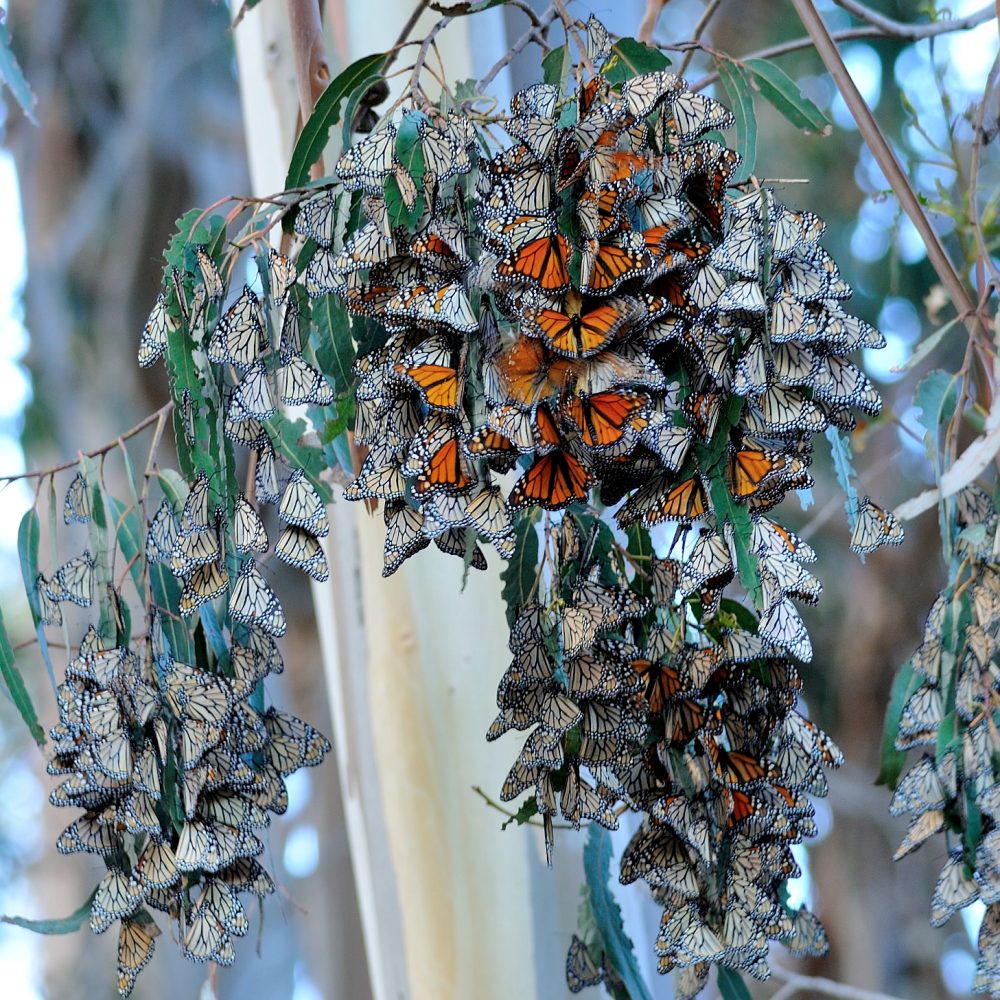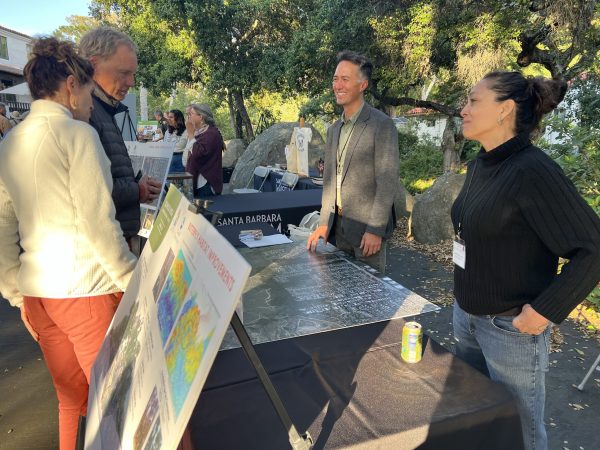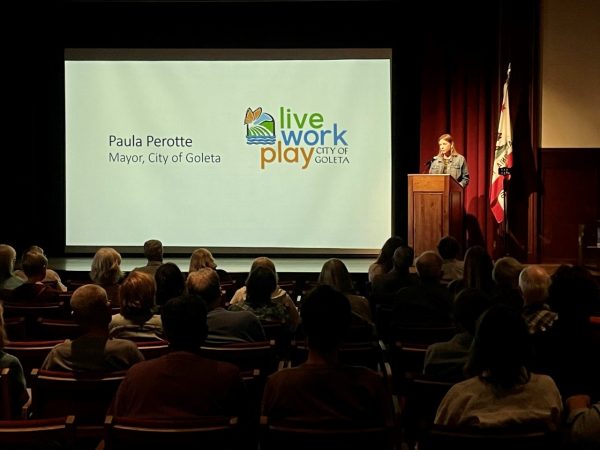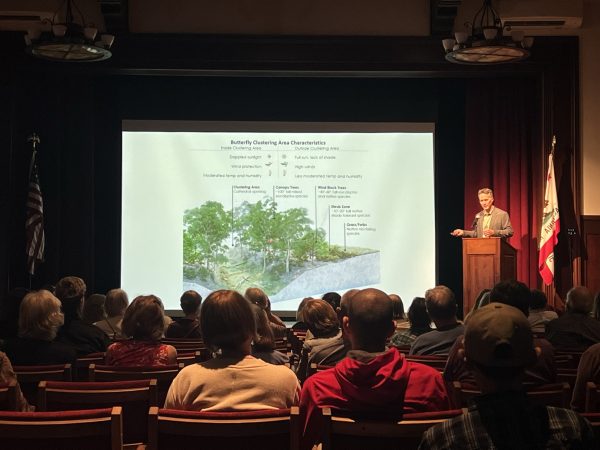
Watch Informative Event Held at SB Museum of Natural History
A group of locals now know more about how to help the western monarch butterfly population after an informative, well-attended event at the Santa Barbara Museum of Natural History. Approximately 175 people packed the Fleischmann Auditorium on May 12, to learn more about a topic near and dear to our community. Attendees at the free event hosted by the City of Goleta and the Museum heard from the City’s monarch butterfly team and had the chance to review project plans, maps, educational materials, and other monarch related items. The Land Trust for Santa Barbara, Rincon Consultants, Inc., RRM Design Group, Santa Barbara Botanic Garden, Santa Barbara County Fire Department, Santa Barbara County Fire Safe Council, and the Santa Barbara Zoo were also on hand to answer questions and provide resources for the community. If you missed it, you can watch a recording of the event here: https://youtu.be/1Iws9ubxiJg.
Mayor Paula Perotte opened the presentation by highlighting the City’s deep connection and commitment to the Monarch Butterfly Grove at Ellwood Mesa. Following, LynneDee Althouse honored her late husband, Dr. Dan Meade, who studied monarchs at Ellwood and elsewhere since the 1990s. Dr. Meade was the City’s lead monarch scientist from 2010 until his unexpected death in late 2022. LynneDee Althouse continues Dan’s work for the City with a team of scientists at Althouse & Meade, Inc. and Creekside Science.
Additional speakers included:
- Ashley Fisher of the Xerces Society of Invertebrate Conservation gave an overview on monarch butterflies, their migration, and the significance of the overwintering habitat at Ellwood Mesa, which regularly ranks in the top 10 most important sites for monarchs along the California coast.
- Charis van der Heide from Althouse & Meade showed us how bi-weekly counts of monarchs at Ellwood Mesa over the past decade inform us when and where the butterflies use specific areas of the Butterfly Grove throughout the winter and during storm events.
- Stu Weiss from Creekside Science explained why monarchs come to Ellwood Mesa and how they seek a combination of wind protection and filtered sunlight to survive the winter.
- Kyle Nessen described how Althouse & Meade uses a sophisticated technology called LiDAR imaging to map the living trees, standing dead trees, and fallen trees throughout Ellwood Mesa, and advanced computer wind modeling to determine the tree density and height that will re-create the conditions needed for overwintering monarchs. This information informs the City’s plans to restore the eucalyptus grove to better support monarch butterflies and other wildlife.
The final speaker was George Thomson, Parks and Open Space Manager for the City of Goleta. He spoke about the history of Ellwood, and the need to improve the monarch habitat and address the extreme fire risk posed by the dead wood in the Ellwood Grove. He reiterated the careful study and planning that has informed the proposed project and showed some project designs of the proposed improvements. Initial work to reduce wildfire risk at Ellwood Mesa is anticipated to begin this summer, pending permits from the California Coastal Commission. Habitat enhancements to improve conditions for overwintering monarch butterflies is expected to begin summer 2024. He also directed the audience to find updates and frequently asked questions on the new Ellwood Mesa section of the City’s website: www.CityofGoleta.org/Ellwood.
Thanks to everyone who attended and for your on-going interest in the efforts underway to help the monarchs.
Funding for the implementation of the Monarch Butterfly Habitat Management Plan is provided by the California State Coastal Conservancy. The Coastal Conservancy is a California state agency, established in 1976, to protect and improve natural lands and waterways, to help people get to and enjoy the outdoors, and to sustain local economies along California’s coast. It acts with others to protect and restore, and increase public access to, California’s coast, ocean, coastal watersheds, and the San Francisco Bay Area. Its vision is of a beautiful, restored, and accessible coast for current and future generations of Californians.
Funding for fire prevention activities in and near Ellwood Mesa (Ellwood Mesa Neighborhoods Hazard Fuel Reduction) is part of California Climate Investments, a statewide program that puts billions of Cap-and-Trade dollars to work reducing GHG emissions, strengthening the economy, and improving public health and the environment– particularly in disadvantaged communities. The Cap-and-Trade program also creates a financial incentive for industries to invest in clean technologies and develop innovative ways to reduce pollution. California Climate Investments projects include affordable housing, renewable energy, public transportation, zero-emission vehicles, environmental restoration, more sustainable agriculture, recycling, and much more. At least 35 percent of these investments are located within and benefiting residents of disadvantaged communities, low-income communities, and low-income households across California. For more information, visit the California Climate Investments website at: www.caclimateinvestments.ca.gov.

George Thomson, Goleta Parks and Open Space Manager, speaking with attendees at an information table



